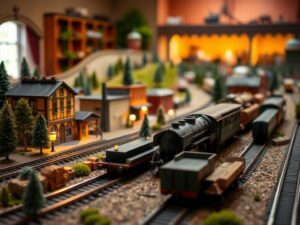Essential Tips for HO Scale Train Maintenance
Essential Tips for HO Scale Train Maintenance
Essential Tips for HO Scale Train Maintenance: Keep Your Tiny Trains Running Smoothly
Welcome to the wonderful world of HO scale model railroading! If you’ve recently jumped into this fascinating hobby, chances are you’re thrilled with the miniature world you’re creating. But as with any intricate mechanism, your HO scale trains require some TLC to ensure they run smoothly and provide years of enjoyment.
Fear not, budding engineers! Maintaining your HO scale fleet doesn’t have to be a daunting task. With a little know-how and consistent effort, you can keep those tiny wheels turning and the trains chugging along their rails for years to come. In this comprehensive guide, we’ll delve into essential tips for HO scale train maintenance, covering everything from cleaning your rolling stock to ensuring pristine track conditions.
Why Maintenance Matters: A Matter of Efficiency & Longevity
Think of maintaining your HO scale trains like taking care of a real car – regular upkeep keeps things running efficiently and extends the life of your investment. Neglecting this essential aspect can lead to:
- Stalling and Rough Operation: Grime buildup on wheels, axles, and gear assemblies hinders smooth motion and increases wear and tear.
- Track Damage: Debris like dust and dirt under wheelsets can warp track, leading to derailments and frustrating experiences.
- Aesthetic Decline: Over time, weathering and dust accumulate on your trains, impacting their visual appeal and overall enjoyment.
Essential Tools for Your HO Scale Workshop:
Gather the right tools before you begin, making your maintenance tasks efficient and effective:
- Tweezers: Perfect for removing debris from tight spots.
- Cotton swabs: Great for applying cleaning solutions and reaching hard-to-clean areas.
- Isopropyl Alcohol: A safe and effective solvent for removing grease and grime.
- Soft brushes: Use nylon brushes (avoid stiff ones) for gentle cleaning of wheels, gears, and couplers.
- Compressed Air Can: An invaluable tool for blowing away dust and debris from track and train components.
- Train Cleaning Lubricant: Specialized oils reduce friction and enhance performance.
- Small screwdriver set: For adjustments to small parts like coupling mechanisms or wheel axles.
Step-by-Step Guide to HO Scale Train Maintenance:
1. Inspect Your Trains Before Every Run: A quick visual inspection can reveal potential issues before they become major problems.
- Wheels and Axles: Check for dirt, grease, or excessive wear. Ensure all wheels rotate freely.
- Couplers: Examine for loose connections, broken parts, or bent mechanisms.
- Gear Assembly: Listen for grinding sounds that might indicate gear damage.
- Bodywork: Inspect for cracks, fading paint, or detached details.
2. Regular Cleaning: Keeping it Sparkling!
A good cleaning regimen keeps your trains in top condition. Follow these steps:
- Remove Debris: Use compressed air to gently blow away dust and dirt from the entire train.
-
Wheels and Axles: Gently apply isopropyl alcohol to a cotton swab and rub wheels and axles, removing grime and grease. Wipe dry with a clean cloth. Avoid excessive force to prevent damaging delicate parts.
- Note for Beginners: If you notice stubborn rust on the axles or wheels, consider applying a small amount of specialized train cleaning lubricant before using a soft brush to gently remove it.
- Couplers: Disassemble the couplers and use isopropyl alcohol and a soft brush to clean their components. Wipe them dry before reassembling.
3. Track Maintenance: The Backbone of Smooth Operations:
The track forms the foundation for your entire layout.
- Inspect Regularly: Look for bent rails, loose track sections, debris like rocks or dirt, and damaged tie-down screws.
- Cleaning Rails: Run a cleaning train, ideally with specialized brushes or damp cloths (wrung out well), along your tracks to remove accumulated dirt and oxidation. Use a mixture of water and vinegar occasionally for tougher grime.
- Check Connections: Tighten any loose screw connections and ensure track sections align correctly to prevent misalignment and derailments.
- Weathering Your Tracks: Adding realistic weathering effects enhances the aesthetic appeal of your layout. Experiment with weathering powders or acrylic paints for a more natural look.
4. Lubrication: Smoothing Out Friction:
Regular lubrication is essential for smooth, long-lasting performance:
-
Wheel Bearings and Axles: Apply a drop or two of specialized train oil to each wheel axle’s bearing area using a cotton swab. Ensure the oil seeps into the bearing but doesn’t overload it.
- Caution for Beginners: Avoid using household oils as they can gum up internal components over time.
5. Gear Maintenance: Keep Things Turning Silently
Gears are vital for transferring power from your locomotive to the wheels:
- Inspection: Regularly inspect gears for wear and tear. Smooth, clean gear teeth indicate good condition.
- Cleaning and Lubrication: Carefully remove gears (consult your train’s manual) and use isopropyl alcohol and a soft brush for cleaning. Apply a small amount of specialized lubricant after cleaning. Reassemble gently and test for smooth rotation.
6. Wiring and Electronics: Keep it Flowing
Electrical components require care too!
- Loose Connections: Check for loose connections at lights, speakers, or power pickups.
-
Damaged Wires: Inspect wires for fraying, short circuits, or breakage. Replace damaged wiring as needed.
- Tip for Advanced Enthusiasts: Invest in a multimeter to check electrical continuity and voltage levels.
7. Storage Solutions: Protect Your Collection
-
Dust-Free Environment: Store trains in a dry, dust-free environment. Use covered cases or cabinets to minimize exposure to airborne particles.
- Temperature Control: Avoid storing your HO scale trains in extreme temperatures, as they can warp or damage components.
- Train Lifts: Using dedicated train lifts allows for easy access and prevents unnecessary strain on your trains.
Maintenance FAQs: Answers at Your Fingertips
Q: How often should I clean my HO scale trains?
A: Aim for a good cleaning session every few runs or before significant track use. A quick inspection and debris removal between runs is always beneficial.
Q: What type of lubricant is best for HO scale trains?
A: Use specialized train lubricants like silicone-based oils. Avoid household oils as they can attract dirt and gum up delicate mechanisms over time.
Q: My locomotive has become sluggish. What should I do?
A: Check your wheel axles and gear assemblies for excessive grime or wear. Cleaning them thoroughly, followed by a touch of lubricant on the axle bearings, may solve the problem.
Closing Thoughts: Embarking on a Journey of Maintenance Mastery
HO scale train maintenance is more than just routine tasks – it’s an opportunity to connect with your trains, appreciate their intricate engineering, and ensure they provide countless hours of joy. By following these essential tips, you’ll keep your little locomotives running smoothly for years to come. Remember, even seasoned model railroaders learn something new every day! Stay curious, share your experiences, and let’s keep those HO scale worlds chugging along together.
Keep those wheels turning, folks!




